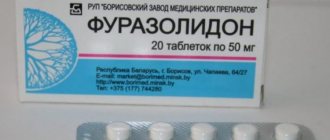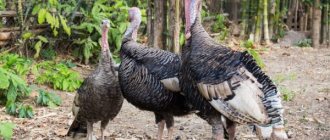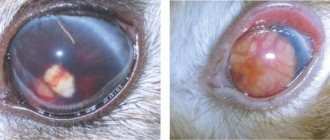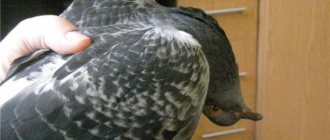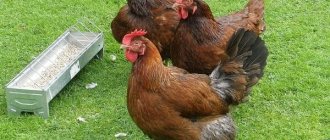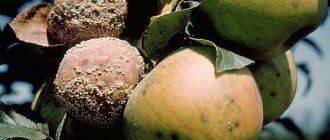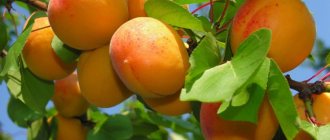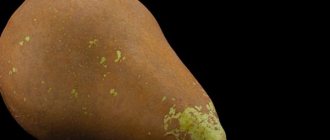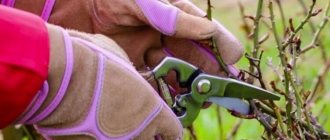» Poultry farming » Turkeys » How to treat sinusitis in turkey poults - important recommendations
0
827
Article rating
Sinusitis in turkey poults often appears between the ages of 2 weeks and 4 months. Frequent causes are inadequate living conditions and improper care. Let's look at the main symptoms of the disease and methods of treatment, and also discuss the rules for raising poultry.
- Preventive measures
- Temperature maintenance
- Comfortable microclimate
- Diet
- Poultry house disinfection
How to treat sinusitis in turkey poults - important recommendations
Causes of the disease
Sinusitis (respiratory mycoplasmosis) is an infectious disease. Belongs to a class of respiratory diseases that are transmitted by airborne droplets. Affects the respiratory system. The disease is serious and requires a special approach to both treatment and subsequent measures.
Pathogens
Sinusitis, which occurs in turkeys, is provoked by a pathogen that does not belong to the class of bacteria. It also does not apply to viruses. Mycoplasma galisepticum is a specific unicellular form, something between a virus and a bacterium.
Mycoplasma grows on nutrient media and multiplies by binary fission. It is unicellular:
- actively multiplies, affecting the mucous membrane of the respiratory tract;
- depletes the bird by parasitizing on it;
- makes its victim vulnerable to any other diseases.
Reasons for the origin of the pathogen
The causes of outbreaks of infectious diseases in poultry houses are considered to be violations of sanitary conditions in the premises, for example:
- dirty equipment and inventory;
- stale litter;
- spoiled food;
- waste decomposition products;
- mustiness in the air.
There are a number of factors that also cause almost as much as poor sanitation on a poultry farm:
- cold, draft in the poultry house;
- dampness, due to which pathogenic bacteria grow;
- weak immunity of pets;
- lack of vitamins;
- stress among chicken coop inhabitants.
Turkeys become quite susceptible to illness in the fall and winter, as the immune system becomes most vulnerable at this time.
How is it transmitted?
The level of infectiousness is very high. Respiratory mycoplasmosis is capable of rapid spread among birds. If it appears in the same room with turkeys, it covers the entire farm at high speed.
Sinusitis is transmitted in several ways:
- from infected eggs;
- by direct contact among birds;
- from airborne dust;
- through liquid;
- through infected food;
- through contaminated premises and equipment;
- through the hands of the farmer.
Who is at risk?
The greatest risk of infection is with turkey poults under 12 weeks of age and turkeys during laying. Babies have a hard time with this disease, especially if the bird is less than four weeks old.
They also, unlike adults, have a greater risk of complications. The reason for this statistics is that the immune system of young individuals is not yet sufficiently developed and protected.
Preventive measures
It is much easier to prevent the development of pathology than to deal with its consequences. For prevention, it is worth taking a number of measures.
Temperature compliance
The temperature regime is selected taking into account the age of the birds:
- In the first 7 days of life, the room temperature should be +32-34 degrees.
- For 8-14 days, the temperature should be gradually reduced. It should be +28-32 degrees.
- On days 15-21, the temperature parameters are set at +26-28 degrees.
- From day 22 the temperature can be +18 degrees.
Conditions of detention
Living conditions are of great importance for the prevention of sinusitis. It is recommended to follow these rules:
- There should be no more than 10 birds 8 weeks old per 1 square meter. As for adult turkeys, their number should not exceed 3.
- It is strictly prohibited to keep turkeys with other species of birds.
- The litter in the poultry house needs to be changed every day.
- It is important to ensure good ventilation. There should be no drafts.
Diet
A quality diet is important. It should contain a sufficient amount of vitamins and minerals. To do this, birds should be given greens and fresh vegetables. It is recommended to include grains in the menu - corn, wheat, oats. Birds should also be given legumes and root vegetables.
Symptoms of the disease
Sinusitis, like most other diseases, has an incubation period (1-3 weeks).
With good care, the disease does not manifest itself for a long time, but, being detected and identified at the right time, it is treated without complications.
Occurs in the following forms:
- acute;
- chronic.
The first is characterized by the following features:
- mucous fluid is released from the nose and eyes;
- labored breathing;
- the larynx and surrounding space swell;
- wheezing, whistling;
- sneezing;
- tumors;
- sticking of the eyes;
- young animals grow and develop much more slowly.
Chronic is characterized by the following symptoms:
- decreased productivity;
- underweight;
- purulent discharge from the eyes and nose;
- photophobia;
- stopping weight gain.
Eye diseases in turkey poults
Harmful dust particles in the room where young animals are kept can lead to eye diseases in turkey poults. High concentrations of dust and gases can cause serious inflammation of the cornea in young animals.
With timely treatment, they will not leave serious consequences. Turkey poults at 2 months suffer from eye diseases just as hard as two-week-old poults. Advanced forms can provoke unpleasant complications, since the body of a young bird does not yet know how to cope with the slightest inflammatory processes.
One of the most common eye diseases is conjunctivitis.
How to treat conjunctivitis in turkey poults
This disease can be immediately noticed by profuse lacrimation and suppuration of the eyes. If treatment is not started, the eyes will become covered with an accumulation of purulent discharge, and the turkey poults will not be able to open them. Sometimes purulent mucus can also come from the bird's nasal passages.
A chick can get conjunctivitis due to a weakened immune system and a cold. This means that the conditions of detention are unsuitable. The first step is to move the cage with the turkey poults to a warm and dry room. The bird’s diet should be reviewed and strengthened with vitamin supplements. Sick turkey poults need to regularly wash their eyes with a boric acid solution and, if necessary, treat with antibiotics. Use chloramphenicol drops, 1 drop in the morning and evening.
There should always be order in the outbuilding where the chicks are kept. Measures for regular preventive disinfection of bedding and equipment will help avoid conjunctivitis. Treatment is carried out at least once a quarter, unscheduled when turkey poults are imported from other poultry houses.
Mechanism and stages of the disease
The peculiarity of sinusitis is that the symptoms in the early stages are almost invisible, and it is very easy to allow the spread of mycoplasma.
How does the body get damaged?
After a bird is infected, the mechanism for spreading the pathogen throughout the body is triggered:
- Onset of the disease. When the infected mycoplasma first enters the mucous membrane, it attaches to the cells.
- The pathogen infects the cell, after which it begins to divide.
- As a result of an increase in the mass of infected mycoplasma, it ends up in the blood.
- Respiratory mycoplasmosis spreads throughout the body through the blood.
- Intoxication occurs and inflammatory processes are started.
If the infection is not “neutralized” at the stage of penetration of the infection into the blood, the disease can become chronic.
Stages of the disease
Veterinary scientists distinguish 4 main stages of the disease:
- From 12 to 21 days pass before antibodies are formed. This is the latent stage.
- The next one lasts from 1 day to 3 weeks. Then sinusitis affects about one tenth of all the inhabitants of the chicken coop.
- The third stage lasts 7-32 days. By this time, the vast majority of turkeys have developed antibody cells.
- The last stage lasts until about 3 weeks.
Methods for treating and diagnosing sinusitis
If your turkey poults have sinusitis, you should know exactly how to treat it. If you want to diagnose a similar disease in turkey poults and adults, then you need to monitor the general symptoms as carefully as possible and conduct a special laboratory test. Due to the fact that identifying the causative agent is quite difficult and time-consuming, you should contact a trusted laboratory, which will make a high-quality diagnosis and identify the causative agent of such a disease.
At the same time, the process of treating turkeys for sinusitis implies the mandatory use of antibiotics, since it is completely impossible to get rid of the infection by other means. It often happens that farmers do not provide full treatment, but simply eliminate the initial symptoms. Because of this, their livestock simply suffers and a real epidemic arises. In addition, you should know that the process of treating turkey sinusitis with conventional folk remedies will not be effective at all. As for the choice of antibiotics that will help relieve sinusitis in turkeys, in most cases this includes antibiotics of the so-called tetracycline group. Therefore, you can safely treat turkey poults:
- tetracycline;
- furazolidone;
- tetramycin;
- typhosine;
- erythromycin;
- frazidin.
Very often, farmers treat turkey poults and adults with an injectable form of tylosin and tartrate. How to treat sinusitis in turkey poults with similar drugs; for this, there are detailed instructions for their use. Most often, in the first stages, only one injection is enough for the bird, after which a 30-day break should be taken. If you notice that the treatment does not give the desired result, then it is advisable not to prolong the process and send the bird for slaughter. Most often, even after using such medications, the disease returns. You can also try mixing antibiotics into the water that the bird drinks. Also pay attention to the fact that the meat is not contaminated with an antibiotic; you must stop giving it approximately two days before the intended slaughter.
As a control, it is advisable to kill the cured bird immediately after treatment. If you notice an infection among adult birds that will be parents, then it is recommended to destroy all eggs in the incubator, and first treat the parents so that they cannot infect other birds and are immediately sent for slaughter.
Diagnostics
The range of symptoms of the disease in question is quite wide. Without a competent examination and biological analysis, it is not possible to determine the presence and stage of the disease.
If you suspect sinusitis:
- Conduct laboratory tests immediately.
- Do not stop monitoring the bird’s condition and the dynamics of symptomatic manifestations.
Laboratory research takes a long time. The sooner you contact the clinic, the greater the chance of starting the correct treatment in a timely manner. Contact an official veterinary institution with a good reputation that has all the special certificates.
Histomoniasis
This is a specific disease, which can be carried by other animals, but only turkeys get sick. Treatment of this disease is problematic, so it is important to pay sufficient attention to its prevention.
Preventive measures:
- It is advisable that turkeys do not have any contact with other animals;
- It is recommended to keep birds of different ages separately;
- For turkeys, cleanliness and hygiene are of particular importance;
- prophylaxis using metronidazole (for turkey poults);
- timely deworming;
- compliance with standards for content density.
Symptoms
One of the distinctive symptoms is darkening of the head (due to which the disease is also called “black head”). There are also a number of other noticeable symptoms:
- lack of appetite, lethargy, frizz;
- diarrhea with yellow-green and then brown feces;
- rapid weight loss and exhaustion.
The disease affects the liver, as can be seen upon autopsy - it is all covered with light spots.
Treatment of histomoniasis
As mentioned above, the disease is difficult to treat, so proper prevention is very important. A sick bird must be immediately isolated to prevent infection of other birds. For 10 days, the turkey is given a metronidazole solution (2 tablets must be dissolved in a liter of water). Usually the bird's condition improves within a day. Other birds also need to add 250 mg of metronidozole per kilogram of feed to their food for 5 days.
Treatment
Veterinarians and experienced farmers take a comprehensive approach to the treatment of sinusitis in turkeys. Based on the laboratory test results, be sure to consult a specialist. He will prescribe the necessary medications and give recommendations for treatment, taking into account all the nuances of the ongoing illness.
Traditional treatment used without special drugs is not always effective.
Quarantine
Before you begin to fight the disease that has affected your turkeys, be sure to protect healthy individuals. Quarantine measures help prevent further spread of the disease in the poultry house.
If there is an outbreak of sinusitis on your poultry farm, immediately clean and disinfect the common chicken coop after quarantining sick people.
The duration of quarantine is at least 3 weeks.
For sick birds in the quarantine department, provide all the necessary conditions for recovery. This includes:
- Mandatory regular ventilation of the room . The measure is necessary to ensure access to fresh air, oxygen, and to reduce the number of pathogens.
- Maintaining optimal temperature. Maintain it at +20-25°C. Also carefully check for drafts. If you find them, eliminate them immediately.
- Maintaining perfect cleanliness. Change the bedding daily and wet clean the room. This should include thorough disinfection of the entire space adjacent to the quarantine department.
- Ensuring you have enough to drink. Give clean water in large quantities. Water temperature is room temperature.
- Special diet. The bird's immune system needs thoughtful nutrition now more than ever. The diet should include vitamins and minerals. Decoctions of medicinal herbs (for example, wormwood, chamomile, mint, nettle) and solutions of special vitamin and mineral complexes are suitable.
Drug treatment
After the doctor has accurately established the diagnosis, medications are prescribed. These are antibiotics and drugs to neutralize the pathogen and strengthen the immune system.
Antibiotics
Antibiotics of the tetracycline group are mainly prescribed. They have proven their effectiveness in practice. This includes:
- Farmazin;
- Tetracycline;
- Tyfosine;
- Furalizod.
Antibiotics are introduced into the body through dilution with drinking water.
Each drug has its own dilution proportions. Your attending veterinarian will inform you about them. Also, the dosage must be indicated in the instructions for the medications.
In case of severe symptoms, the sinuses are cleared of secretions and washed with the same solutions of water and antibiotics. If 2-3 days after washing there are bags of liquid left on the turkey’s head/neck, pump it out with a syringe. Rinse the vacated cavity thoroughly with Chlorhexidine.
Tylosin-200 and Farmazin-500 are also used. Swelling can be relieved well with Voltaren or Diclofenac.
Drugs that strengthen the immune system
In addition to antibiotics, birds are fed various vitamin and mineral complexes, such as Trivitamin or Chiktonik. These drugs contain correctly selected and balanced amounts of substances needed to support the immune system.
It is advisable to carry out such feeding of healthy individuals as a preventive measure.
The approach to treating young animals in terms of the use of drugs and procedures prescribed by veterinarians is practically no different from the treatment of adult turkeys.
How to properly treat sinusitis in turkeys at home
To properly treat sinusitis in birds, it is important to consult a veterinarian. The specialist will prescribe medications. In addition to such therapy, it is permissible to use folk recipes.
Medications
To cure the pathology, it is worth using antibiotics. They are recommended to be injected directly into the cleaned sinuses. If you don’t have the skills, you won’t be able to do it without the help of a veterinarian. Violations in therapy can lead to aggravation of the situation. Most often, the following remedies are used for this diagnosis:
- "Tylosin-200" - for the treatment of turkeys, it is recommended to mix 5 grams of the product with 10 liters of water and feed the birds for 5 days.
- “Farmazin-500” - to eliminate pathology, it is recommended to use 1 gram of the drug per 1 liter of water and give the solution to birds twice a day for 10 days.
Farmazin-500 can also be injected into the sinuses. To do this, use 2 milligrams of the product. The use of such substances has a powerful effect on the immune system, so you cannot use them yourself.
Traditional methods and recipes
Treatment of a runny nose with folk remedies does not produce the desired effect. To eliminate the disease, antibiotics must be used. At the same time, folk recipes help strengthen the immune system and increase resistance to pathologies. This helps stimulate healing.
For maintenance treatment it is worth using the following means:
- Infusion of strawberry berries and leaves. It helps strengthen the immune system of birds, slightly reduces temperature parameters, and reduces nasal discharge. It is recommended to give this product to turkey poults instead of water 3 times a day.
- Chamomile decoction. This substance successfully copes with the symptoms of inflammation in the nose, reduces swelling, and helps strengthen the immune system. It should be given several times a day.
See also
Types of feeders for turkeys and how to make them yourself, drawings and dimensionsRead
Aftercare
The recovery period after illness has its own nuances:
- continue to keep the recovered turkey warm;
- make sure the room is dry;
- make sure that the bird is not exposed to direct sunlight;
- provide three meals a day;
- continue to change the litter daily, as pathogens still live in feces;
- If necessary, feed the turkeys with medicinal preparations for a few more days.
Worms in turkey poults
Worms in poultry are a very common phenomenon. Turkeys can become infected with worms through food, contaminated water, and dirty bedding. Moreover, they can get into the gastrointestinal tract and respiratory organs.
Symptoms are mild. You may not immediately understand that the turkey poults are sick.
But gradually the bird loses weight, its legs become thin and cannot support even a small weight. Immunity is reduced to a minimum.
Veterinarians most often prescribe phenothiazine or piperazine sulfate to birds. You can also use other new generation pharmaceutical drugs. The regimen of drinking drugs against worms is combined with enhanced nutrition, disinfection of the premises and equipment.
We recommend: Incubation of turkey eggs, all the important points and nuances, as well as instructions for hatching.
Infections in young animals
The fragile organism of chicks reacts to diseases more acutely than adults. Especially when it comes to infections, there is often a risk of losing an entire young population if symptoms are not detected in a timely manner.
Hemophilosis
Hemophilosis virus
An infectious type of runny nose that is easily transmitted from one chick to another through contact with an affected individual, food, water or tools with which you work with animals. A particular risk of disease exists in turkey poults before reaching the age of five months.
Typical manifestation of hemophilosis:
- inflammation of the mucous membranes of the nasopharynx and eye area;
- discharge in the form of tears and snot;
- wheezing in the chest, shortness of breath;
- lack of appetite, the consequence of which is cessation of growth.
A characteristic sign at a late stage of development of the disease is that due to inflammation of the suborbital sinuses, the bird’s head becomes like an owl’s.
There are no methods for treating such a runny nose - patients will have to be killed.
To prevent an epidemic among the livestock, the premises are disinfected with formaldehyde, dissolving it at a rate of 2% in water, with additives in the form of caustic soda - 2%, freshly slaked lime - 20%.
The entire mixture must be brought to a temperature of 70-80 degrees Celsius. Healthy chicks are inhaled with iodine and the addition of chlorine-turpentine.
Histomoniasis
The causative agents of histomoniasis are protozoan microorganisms that attack the liver and intestines. Turkey poults are most susceptible to the pathogen. The source of infection can be food.
The pathogen does not survive in a free environment, but survives well for a long time in transit hosts - worm eggs, earthworms, flies, or in droppings preserved from an infected bird.
The disease has several stages: acute, subacute and chronic. Symptoms of the disease: exhaustion of the body; diarrhea; intoxication; development of peritonitis.
In the acute phase in turkey poults:
- wings drop;
- no appetite;
- the skin on the head becomes bluish in color;
- diarrhea begins;
- swamp-green feces with a strong unpleasant odor appear;
- The turkey closes his eyes and hides his head under his wing.
The duration of the disease in the acute phase is 1–3 weeks. The peak incidence occurs at the beginning of summer and is associated with the abundance of insects that young animals eat.
For treatment, Metronidazole is used, which is added to the mash at a dosage of 1.5 g per 1 kg of feed. The drug can be dissolved in water and instilled into the bird’s beak at the rate of 0.1 mg per 1 kg of bird weight. The duration of the course is 7 days, with daily dosing of the drug.
For the next 7 days, Metronidazole is added to food once every 2 days.
The prognosis of treatment depends on the condition of the livestock before the disease. Strong turkey poults with a stable immune system will tolerate the disease more easily. In weakened livestock, mortality can reach 70–90%.
Meat from slaughtered poultry must be heat treated when consumed. The entrails should not be eaten by humans or animals. Of all poultry, histomonosis is dangerous for turkey poults. Therefore, transfer the chicks to p
Pullorosis
Aka “white diarrhea”. It is believed to be a disease of young animals. In fact, there are two variants of the disease: “child” and “adult”.
Their symptoms differ beyond recognition of the disease, so people often believe that white diarrhea in turkey poults and problems with the reproductive system of turkeys are different diseases and there is nothing in common between them.
In turkey poults, pullorosis causes septicemia, colloquially “blood poisoning,” damage to the gastrointestinal tract and respiratory system. In an adult bird there is inflammation of the ovaries, oviduct and vitelline peritonitis.
Symptoms of the “children’s” version of pullorosis
Pullorosis in turkey poults is divided into two types: congenital and postnatal. With congenital turkey poults are hatched from already infected eggs, with postnatal poults they become infected when sick and healthy turkey poults are reared together.
Congenital pullorosis. The incubation period is usually 3 to 5 days. Sometimes it can reach up to 10.
Main symptoms:
- refusal of food;
- weakness;
- drooping wings;
- ruffled feather;
- poor plumage;
- the yolk is not drawn into the abdominal cavity (in these cases, turkey poults usually do not live longer than 1 day);
- droppings are white, liquid (white diarrhea);
- Due to the liquid droppings, the fluff around the cloaca is glued together with excrement.
In postnatal pullorosis, three courses of the disease are distinguished: acute, subacute and chronic. The incubation period for this form is 2-5 days after hatching of turkey poults from eggs.
Symptoms of postnatal pullorosis in turkey poults during the acute course of the disease:
- indigestion;
- weakness;
- breathing through an open beak rather than through the nasal openings;
- white mucus instead of droppings;
- blockage of the cloacal opening with feces glued together;
- turkey poults stand with their paws spread and their eyes closed.
Subacute and chronic course of the disease occurs in turkey poults 15-20 days of age:
- poor feathering;
- developmental delay;
- diarrhea;
- broilers have inflammation of the leg joints.
The mortality rate for subacute and chronic pullorosis in turkey poults is low.
Symptoms of “adult” pullorosis
In adult turkeys, pullorosis occurs in an asymptomatic form. Periodically, a decrease in egg production, vitelline peritonitis, inflammation of the ovaries and oviduct, and intestinal disorders are observed.
Treatment of the disease
Apparently sick turkeys are destroyed. Conditionally healthy birds are treated with antibacterial drugs, using them according to the regimen prescribed by the veterinarian or indicated in the annotation for the drug.
Important! For preventive purposes, broiler turkey poults are given furazolidone from the first day until almost slaughter.
Prevention
Compliance with veterinary requirements for incubating eggs and keeping and feeding turkeys. A ban on the export and sale of products from farms infected with pullorosis.
Paratyphoid
The causative agent of the disease is Salmonella. The source of infection can be food, household items, infected territory and carriers of infection - recovered turkeys, sick birds, rodents.
Most often, young ducks and geese aged from 2 to 6 weeks are susceptible to the disease. The disease has acute, subacute and chronic forms.
Symptoms of acute paratyphoid fever:
- lethargy, inactivity of the bird;
- the turkey's wings are down, the feathers are ruffled;
- the eyes become watery, purulent discharge is possible, causing the eyelids to stick together;
- the turkey falls on its back;
- the feathers around the cloaca are stained with feces;
- Green diarrhea is possible.
The acute form can result in the death of the turkey in 1–4 days. In the subacute form, inflammatory processes intensify—inflammation of the joints, lungs, etc.
The subacute stage lasts up to 10 days. During this time, 50% of the sick young animals die. If the bird survives these 10 days, then the disease enters the chronic stage with the development of paralysis of the limbs and exhaustion.
Treatment of paratyphoid fever is complex. It necessarily includes both a medicinal component and the implementation of general sanitary measures and the prescription of immunomodulators.
As a preventive measure, the walking yard and poultry house floor are disinfected.
Sick individuals are injected with antiparatyphoid serum intramuscularly at the rate of 2.5 ml per 1 kg of turkey weight. Biomycin hydrochloride is added to the feed twice a day for 5-6 days - 5-10 mg per 1 kg of weight. Instead of regular water, give an aqueous solution of Furacilin (1:5000) to drink for 5–6 days.
Infectious sinusitis
Inflammation of the sinuses Sinusitis
is characterized by severe inflammation of the eye and nasal sinuses, their swelling and redness, visible to the naked eye. The increase in size is achieved due to the large accumulation of pus inside.
Causes:
- too small a space for the herd, leading to overcrowding;
- feathered hypothermia;
- vitamin deficiency of groups A and D.
Such cases can be treated with furazolidone, oxytetracycline, streptomycin, and tilan on a water-soluble basis.
Prevention
With the help of simple preventive measures, you can reduce the risk of developing diseases, as well as the risk of complications. Basic preventive measures when keeping turkeys:
- you need to use only high-quality and balanced food with the necessary content of all elements;
- Disinfection and cleaning of the poultry house should be carried out regularly, at least 2 times a week. It is advisable to treat the walls with special preparations or slaked lime;
- a ventilation system must be organized in the poultry house;
- All routine veterinary examinations and vaccinations should be carried out;
- When the first signs of infection are detected, sick individuals must be isolated.
On large farms, it is advisable to have a full-time veterinarian in order to respond in time to an outbreak of infection in the herd. A specialist will help you follow the vaccination schedule and transfer turkey poults from the brooder to the general poultry house.
Vaccination
Vaccine prevention is an important requirement when raising turkeys. Vaccines can reduce the risk of infection and the development of dangerous complications. The procedures are carried out according to the scheme, starting from 14 days of age. For industrial cultivation, vaccination against Newcastle disease, rhinotracheitis, hemorrhagic enteritis and coccidiosis is mandatory. The drugs are added to drinking water.
Watering turkey poults
To avoid diseases, most poultry farmers feed turkey poults with antibiotics, probiotics and vitamins according to the scheme, starting from the first days of life. The algorithm depends on the breed, weight and conditions of detention. The larger the bird, the more medications are required. The main condition for competent prevention is consistency, as well as strict adherence to dosage. Medicines cannot be mixed; only one type of medicine can be offered at a time. In the first days of life, the following medications are given:
- vitamin supplements;
- antibiotics;
- immunostimulants;
- probiotics.
You can start procedures from 5-8 days; early use of medications can have a detrimental effect on the process of formation of the gastrointestinal tract.
Soldering agents are added to drinking water, and drinking bowls are pre-treated with formaldehyde.
What symptoms are common?
Due to insufficient living conditions, turkeys are susceptible to infectious and non-infectious diseases
When breeding and keeping poultry, it is necessary to promptly identify and distinguish between signs of the disease. Due to the weak immunity and instability of turkeys to diseases, even a minor pathology develops quickly and can lead to death. Main symptoms of the disease:
- a sharp decrease or change in motor activity (the turkey falls on its feet, moves little or too actively, sits in one place for a long time);
- the bird avoids contact with other individuals and hides in a corner;
- the plumage loses its gloss and smoothness , there are areas of baldness and dishevelment;
- no sparkle in the eyes, dull look;
- wings down;
- refuses food and drink;
- diarrhea is observed in turkeys;
- Digestive problems appear , the structure and color of stool changes.
Poultry try to avoid sick individuals. They can attack or prevent the individual from approaching the common feeding trough. Adult males behave especially aggressively.
At the first signs of disease, the turkey must be isolated from the general herd and diagnosed. It is advisable to use not only visual inspection, but also laboratory tests.
Non-contagious
Hard goiter
Photo:
This usually happens if the bird has been starving for a long time and after the hunger strike eats food too greedily. After feeding, the turkeys go to drink. Whole grains accumulated in the crop swell from water, swell the crop and clog the esophagus.
The lack of stones or shells for grinding grain can only affect the stomach. In this case, the root cause of a hard goiter is a blockage of the intestines at the exit from the stomach.
This does not happen when feeding turkeys with factory-made compound feed, since when water gets on the feed, the latter immediately soaks into a pulp, for the assimilation of which even pebbles are not needed. If the turkey drinks enough water, the mush becomes liquid.
Theoretically, a turkey's crop can be surgically opened and the swollen grain removed. But this procedure must be carried out by a veterinarian, and therefore it is usually more profitable to slaughter turkeys than to treat them.
Symptoms
Apathy. When palpated, the goiter is hard and tightly packed. Turkeys refuse to feed.
There is exhaustion and a decrease in egg production in turkeys if the disease develops during the laying season. Due to the pressure of the crop on the trachea, turkeys have difficulty breathing, which subsequently leads to death from suffocation.
Treatment
When clogged, the turkeys' crops are opened and their contents are surgically removed. After this, Vaseline oil or sunflower oil is injected into the bird’s crop. After massaging the crop, the contents of the crop are removed, essentially squeezed out through the esophagus.
Important! To prevent the disease with hard goiter, turkeys need to be fed regularly, without allowing long breaks; it is better not to use whole, easily swelling grains in the diet of turkeys.
saggy goiter
One of the varieties of hardened goiter. It occurs in a milder form and is therefore treatable.
It occurs as a result of unbalanced nutrition, excessive consumption of water, prolonged stay in too hot and stuffy rooms, as well as in the summer in the sun. As a result, the animal's goiter stretches and sag.
As a treatment, a special diet is prescribed - it is prescribed by a veterinarian on an individual basis (the components of the diet directly depend on the bird’s diet).
In addition, victims need complete rest - as little movement and contact with other members of the pack as possible.
Pica
Another striking example of the lack of useful substances in soldering. To replenish the necessary reserves, the turkey begins to eat things unusual for it - stones, feathers, sawdust, nest litter.
Treatment involves a simple revision of the bird’s diet, saturating it with all the necessary microelements and vitamins.
Problems with paws
Problems with the development of the bone apparatus and a lack of calcium may be the reason that birds are very unstable and have weak leg muscles.
If the turkey poults do not have enough space to roam, this may also be the cause of the fall. In addition, problems with paws may arise due to their inversion.
If the turkey chick is unstable, but at the same time actively eats and looks cheerful, then the problem lies in the diet. If the bird looks sleepy, lethargic, and hides in a secluded place, then this is a sign of infectious infection.
Loose leg joints are a sign of arthritis. In this case, there is swelling around the joint. To treat arthritis, an aqueous solution of mumiyo is used at the rate of 0.4 mg per 100 g of bird weight.
The solution is given instead of drinking for 10 days. A 5-minute rubbing of an 8% mumiyo solution into the inflamed joint is also used.
Additional vitamins B and D are introduced into the poultry diet. Cake is removed from the diet to reduce the fat content of the feed. Treatment of infectious diseases is prescribed depending on the diagnosis made by the veterinarian.
Cleaning and disinfection
The key to good health for turkeys is also the cleanliness of the premises. If a case of infectious sinusitis is recorded on the farm, the sick individual should be immediately separated from others, and the poultry house should be disinfected:
- the room is thoroughly washed with plain warm water;
- the poultry house is dried for three days;
- Then the walls, ceiling, floor and all equipment are treated with disinfectants: a solution of potassium permanganate or slaked lime.
After disinfection measures, new birds are introduced into the house after 14 days. As a disease prevention measure, the poultry house is disinfected once a month.
Parasitic diseases of turkeys: symptoms, treatment
In the absence of timely measures, parasites can cause damage to the entire livestock . Carriers of pathogens are wild birds and rodents; the person himself brings them on clothes or shoes.
In the absence of timely measures, parasites can cause damage to the entire livestock
Parasites can be either internal (worms) or external (lice, ticks, lice).
The pathology can be recognized by its characteristic symptoms:
- partial loss of feathers;
- sudden weight loss;
- developmental delay;
- decreased appetite;
- bare areas of skin.
To combat internal parasites, the drug Phenothiazine is used, which is added to the feed in a ratio of 1 to 15. Therapy is carried out for 2 days with morning feeding.
It is also effective to use piperazine sulfate 1 g per 1 kg of live weight with the morning meal. Duration of treatment – 10 days.
To combat external parasites, the feathers of the entire livestock are treated with one of the following means:
- Permethrin 0.5%;
- Dicresyl 0.7%;
- Dibrom 0.05%.
Therapy should be carried out twice at intervals of 9-12 days. All surfaces of the poultry house are also treated.
